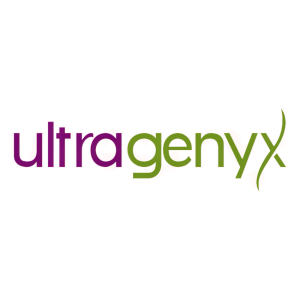Ultragenyx Completes Enrollment of Phase 3 Aspire Study Evaluating GTX-102 for the Treatment of Angelman Syndrome
Rhea-AI Summary
Ultragenyx Pharmaceutical (NASDAQ: RARE) has completed enrollment for its Phase 3 Aspire study of GTX-102 (apazunersen) for Angelman Syndrome treatment. The study successfully enrolled 129 participants aged 4-17 with confirmed maternal UBE3A gene deletion in just seven months.
The trial design includes a 1:1 randomization between GTX-102 intrathecal injection and sham control, with active treatment consisting of three monthly 8 mg loading doses followed by maintenance doses up to 14 mg quarterly. The study's primary endpoint focuses on cognitive improvement measured by Bayley-4 cognitive raw score, with completion expected in second half of 2026.
Additionally, Ultragenyx plans to initiate the Aurora study of GTX-102 in additional ages and genotypes in the second half of 2025.
Positive
- Rapid enrollment completion in just 7 months demonstrates strong patient interest and urgent market need
- Promising preliminary results from Phase 1/2 study showing developmental gains
- Treatment targets the underlying genetic cause of Angelman syndrome, currently an untreated condition
Negative
- Long timeline to study completion (second half of 2026)
- Complex treatment administration requiring intrathecal injection via lumbar puncture
News Market Reaction 1 Alert
On the day this news was published, RARE gained 4.10%, reflecting a moderate positive market reaction.
Data tracked by StockTitan Argus on the day of publication.
Company expects to complete Phase 3 Aspire study in the second half of 2026
Aurora study of GTX-102 in additional ages and genotypes on track to initiate in the second half of 2025
NOVATO, Calif., July 31, 2025 (GLOBE NEWSWIRE) -- Ultragenyx Pharmaceutical Inc. (NASDAQ: RARE) today announced that the Phase 3 Aspire study evaluating GTX-102 (apazunersen) as a treatment for Angelman Syndrome is fully enrolled, with approximately 129 participants ages four to 17 with a genetically confirmed diagnosis of full maternal UBE3A gene deletion.
“The accelerated enrollment of the Phase 3 Aspire study underscores the urgent need and strong desire for an effective treatment for these patients. Support from the Angelman syndrome community was critical to the achievement of this important milestone for GTX-102 with completion of enrollment in seven months. We are grateful to the study site teams, investigators, and families for their dedication and support,” said Eric Crombez, M.D., chief medical officer at Ultragenyx. “The continued developmental gains observed in the Phase 1/2 study provide a strong foundation as we advance this program with the potential to address the underlying genetic cause of this disease and enhance the quality of life for children living with Angelman syndrome.”
Jean-Baptiste Le Pichon, MD, PhD, FAAP, Interim Division Director, Neurology; Madison Lauren Sargent Endowed Professorship in Neurology/Angelman Syndrome, Children’s Mercy and an investigator on the Aspire study, added: “Today there are thousands of children and adults in the U.S. living with Angelman syndrome, with no cure or hope. To have a treatment in development with the potential to correct the underlying genetic error that forms the basis of Angelman syndrome, restore protein function, and recover function for patients is extremely meaningful. Completing enrollment of this study is a major milestone, and I eagerly look forward to additional data that builds on the promising preliminary results from the previous Phase 1/2 study.”
Enrollment in the global Phase 3 Aspire study (NCT06617429) began in December 2024. Participants are randomized 1:1 to receive GTX-102 by intrathecal injection via lumbar puncture or to the sham comparator group for a period of 48 weeks. Participants in the active treatment group will receive three monthly 8 mg loading doses of GTX-102, followed by dosing in a maintenance period that will increase to a maximum dose of 14 mg of GTX-102 quarterly. Participants in the sham comparator group will be eligible to cross over onto treatment after completing their Week 48 assessments. The primary endpoint will be improvement in cognition assessed by Bayley-4 cognitive raw score, and the key secondary endpoint (with a
About GTX-102 (apazunersen)
GTX-102 (apazunersen) is an investigational antisense oligonucleotide (ASO) therapy delivered via intrathecal administration and designed to target and inhibit expression of the UBE3A-AS to prevent silencing of the paternally inherited allele of the UBE3A gene and reactivate expression of the deficient protein. GTX-102 has been granted Breakthrough Therapy Designation, Orphan Drug Designation, Rare Pediatric Disease Designation, and Fast Track Designation from the FDA and Orphan Designation and PRIME designation from the EMA.
About Angelman Syndrome
Angelman syndrome is a rare, neurogenetic disorder caused by loss-of-function of the maternally inherited allele of the UBE3A gene. The maternal-specific inheritance pattern of Angelman syndrome is due to genomic imprinting of UBE3A in neurons of the central nervous system (CNS), a naturally occurring phenomenon in which the maternal UBE3A allele is expressed and the paternal UBE3A is not. Silencing of the paternal UBE3A allele is regulated by the UBE3A-AS, the intended target of GTX-102. In almost all cases of Angelman syndrome, the maternal UBE3A allele is either missing or mutated, resulting in limited to no protein expression. This condition is generally not inherited but instead occurs spontaneously. It is estimated to affect approximately 60,000 people in commercially accessible geographies.
Angelman syndrome is a lifelong neurodevelopmental disorder that causes cognitive impairment, motor impairment, balance issues and debilitating seizures. Some individuals with Angelman syndrome are unable to walk and most do not speak. Anxiety and disturbed sleep can be serious challenges in individuals with Angelman syndrome. Although individuals with Angelman syndrome have a normal lifespan, they require continuous care and are unable to live independently. Angelman syndrome is not a degenerative disorder, but the loss of the UBE3A protein expression in neurons results in abnormal communications between neurons. Angelman syndrome is often misdiagnosed as autism or cerebral palsy. There are no currently approved therapies for Angelman syndrome; however, several symptoms of this disorder can be reversed in adult animal models of Angelman syndrome, suggesting that improvement of symptoms can potentially be achieved at any age.
About Ultragenyx
Ultragenyx is a biopharmaceutical company committed to bringing novel therapies to patients for the treatment of serious rare and ultra-rare genetic diseases. The company has built a diverse portfolio of approved medicines and treatment candidates aimed at addressing diseases with high unmet medical need and clear biology, for which there are typically no approved therapies treating the underlying disease.
The company is led by a management team experienced in the development and commercialization of rare disease therapeutics. Ultragenyx’s strategy is predicated upon time- and cost-efficient drug development, with the goal of delivering safe and effective therapies to patients with the utmost urgency.
For more information on Ultragenyx, please visit the company's website at: www.ultragenyx.com.
Forward-Looking Statements and Use of Digital Media
Except for the historical information contained herein, the matters set forth in this press release, including statements related to Ultragenyx's expectations and projections regarding its future operating results and financial performance, business plans and objectives for GTX-102, expectations regarding the tolerability and safety of GTX-102, anticipated timing of data from ongoing GTX-102 studies, anticipated timing for initiation and completion of GTX-102 studies, and future clinical and regulatory developments for GTX-102 are forward-looking statements within the meaning of the "safe harbor" provisions of the Private Securities Litigation Reform Act of 1995. Such forward-looking statements involve substantial risks and uncertainties that could cause our clinical development programs, collaboration with third parties, future results, performance or achievements to differ significantly from those expressed or implied by the forward-looking statements. Such risks and uncertainties include, among others, the uncertainty of clinical drug development and unpredictability and lengthy process for obtaining regulatory approvals, the ability of the company to successfully develop GTX-102, the company’s ability to achieve its projected development goals in its expected timeframes, the risk that results from earlier studies may not be predictive of future study results, risks related to adverse side effects, risks related to reliance on third party partners to conduct certain activities on the company’s behalf, smaller than anticipated market opportunities for the company’s products and product candidates, manufacturing risks, competition from other therapies or products, and other matters that could affect sufficiency of existing cash, cash equivalents and short-term investments to fund operations, the company’s future operating results and financial performance, the timing of clinical trial activities and reporting results from same, and the availability or commercial potential of Ultragenyx’s products and drug candidates. Ultragenyx undertakes no obligation to update or revise any forward-looking statements.
For a further description of the risks and uncertainties that could cause actual results to differ from those expressed in these forward-looking statements, as well as risks relating to the business of Ultragenyx in general, see Ultragenyx's Quarterly Report on Form 10-Q filed with the Securities and Exchange Commission (SEC) on May 7, 2025, and its subsequent periodic reports filed with the SEC.
In addition to its SEC filings, press releases and public conference calls, Ultragenyx uses its investor relations website and social media outlets to publish important information about the company, including information that may be deemed material to investors, and to comply with its disclosure obligations under Regulation FD. Financial and other information about Ultragenyx is routinely posted and is accessible on Ultragenyx’s Investor Relations website (https://ir.ultragenyx.com/) and LinkedIn website (https://www.linkedin.com/company/ultragenyx-pharmaceutical-inc-/).
Ultragenyx Contacts
Investors
Joshua Higa
ir@ultragenyx.com
Media
Jess Rowlands
media@ultragenyx.com







